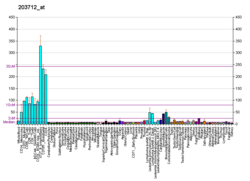| PUM3 |
|---|
|
|
| Identifiers |
|---|
| Aliases | PUM3, D19Bwg1357e, 1110069H02Rik, AA675048, Kiaa0020, HA-8, HLA-HA8, PEN, PUF-A, PUF6, XTP5, KIAA0020, pumilio RNA binding family member 3 |
|---|
| External IDs | MGI: 106253 HomoloGene: 5762 GeneCards: PUM3 |
|---|
|
| Gene location (Mouse) |
|---|
 | | Chr. | Chromosome 19 (mouse)[2] |
|---|
| | Band | 19 C1|19 21.96 cM | Start | 27,388,702 bp[2] |
|---|
| End | 27,429,820 bp[2] |
|---|
|
|
|
| Orthologs |
|---|
| Species | Human | Mouse |
|---|
| Entrez | | |
|---|
| Ensembl | | |
|---|
| UniProt | | |
|---|
| RefSeq (mRNA) | | |
|---|
| RefSeq (protein) | | |
|---|
| Location (UCSC) | Chr 9: 2.72 – 2.84 Mb | Chr 19: 27.39 – 27.43 Mb |
|---|
| PubMed search | [3] | [4] |
|---|
| Wikidata |
|
pumilio RNA binding family member 3 (previously KIAA0020[5]) is a protein that in humans is encoded by the PUM3 gene.[6][7][8]
References
- 1 2 3 GRCh38: Ensembl release 89: ENSG00000080608 - Ensembl, May 2017
- 1 2 3 GRCm38: Ensembl release 89: ENSMUSG00000041360 - Ensembl, May 2017
- ↑ "Human PubMed Reference:".
- ↑ "Mouse PubMed Reference:".
- ↑ "PUM3 Symbol Report | HUGO Gene Nomenclature Committee". www.genenames.org. Retrieved 2017-01-24.
- ↑ Nomura N, Miyajima N, Sazuka T, Tanaka A, Kawarabayasi Y, Sato S, Nagase T, Seki N, Ishikawa K, Tabata S (Dec 1995). "Prediction of the coding sequences of unidentified human genes. I. The coding sequences of 40 new genes (KIAA0001-KIAA0040) deduced by analysis of randomly sampled cDNA clones from human immature myeloid cell line KG-1". DNA Research. 1 (1): 27–35. doi:10.1093/dnares/1.1.27. PMID 7584026.
- ↑ Nomura N, Miyajima N, Sazuka T, Tanaka A, Kawarabayasi Y, Sato S, Nagase T, Seki N, Ishikawa K, Tabata S (Dec 1995). "Prediction of the coding sequences of unidentified human genes. I. The coding sequences of 40 new genes (KIAA0001-KIAA0040) deduced by analysis of randomly sampled cDNA clones from human immature myeloid cell line KG-1 (supplement)". DNA Research. 1 (1): 47–56. doi:10.1093/dnares/1.1.47. PMID 7584028.
- ↑ "Entrez Gene: KIAA0020 KIAA0020".
Further reading
- Maruyama K, Sugano S (January 1994). "Oligo-capping: a simple method to replace the cap structure of eukaryotic mRNAs with oligoribonucleotides". Gene. 138 (1–2): 171–4. doi:10.1016/0378-1119(94)90802-8. PMID 8125298.
- Suzuki Y, Yoshitomo-Nakagawa K, Maruyama K, Suyama A, Sugano S (October 1997). "Construction and characterization of a full length-enriched and a 5'-end-enriched cDNA library". Gene. 200 (1–2): 149–56. doi:10.1016/S0378-1119(97)00411-3. PMID 9373149.
- Hoja MR, Wahlestedt C, Höög C (August 2000). "A visual intracellular classification strategy for uncharacterized human proteins". Experimental Cell Research. 259 (1): 239–46. doi:10.1006/excr.2000.4948. PMID 10942595.
- Brickner AG, Warren EH, Caldwell JA, Akatsuka Y, Golovina TN, Zarling AL, Shabanowitz J, Eisenlohr LC, Hunt DF, Engelhard VH, Riddell SR (January 2001). "The immunogenicity of a new human minor histocompatibility antigen results from differential antigen processing". The Journal of Experimental Medicine. 193 (2): 195–206. doi:10.1084/jem.193.2.195. PMC 2193344. PMID 11148223.
- Andersen JS, Lyon CE, Fox AH, Leung AK, Lam YW, Steen H, Mann M, Lamond AI (January 2002). "Directed proteomic analysis of the human nucleolus". Current Biology. 12 (1): 1–11. doi:10.1016/S0960-9822(01)00650-9. PMID 11790298.
- Warren EH, Otterud BE, Linterman RW, Brickner AG, Engelhard VH, Leppert MF, Martin PJ, Riddell SR (April 2002). "Feasibility of using genetic linkage analysis to identify the genes encoding T cell-defined minor histocompatibility antigens". Tissue Antigens. 59 (4): 293–303. doi:10.1034/j.1399-0039.2002.590407.x. PMID 12135428.
- Scherl A, Couté Y, Déon C, Callé A, Kindbeiter K, Sanchez JC, Greco A, Hochstrasser D, Diaz JJ (November 2002). "Functional proteomic analysis of human nucleolus". Molecular Biology of the Cell. 13 (11): 4100–9. doi:10.1091/mbc.E02-05-0271. PMC 133617. PMID 12429849.
- Andersen JS, Lam YW, Leung AK, Ong SE, Lyon CE, Lamond AI, Mann M (January 2005). "Nucleolar proteome dynamics". Nature. 433 (7021): 77–83. doi:10.1038/nature03207. PMID 15635413.




